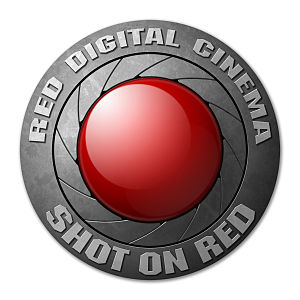
The Arriflex D-21 is a film-style digital motion picture camera introduced by Arri in 2008 to replace their earlier generation Arriflex D-20.

The Arriflex D-21 is a film-style digital motion picture camera introduced by Arri in 2008 to replace their earlier generation Arriflex D-20.
The D-21 uses a Super 35 (4:3 aspect ratio) sized single CMOS sensor and accepts 35 mm film camera lenses (54mm PL mount). It features an optical viewfinder and modular construction. [1]
The D-21 captures images in three general modes: HD ('HD422 (16:9)' or 'HD444 (16:9)'), Mscope, and Data ('ARRIRAW (16:9)' or 'ARRIRAW (4:3)'). Its sensor is a CMOS chip with a Bayer mask, [2] with dimensions of 2880x2160 pixels. [3]

IMAX is a proprietary system of high-resolution cameras, film formats, film projectors, and theaters known for having very large screens with a tall aspect ratio and steep stadium seating.

Red Digital Cinema is an American company that manufactures professional digital cinematography cameras and accessories.

The Arri Group is a German manufacturer of motion picture film equipment. Based in Munich, the company was founded in 1917. It produces professional motion picture cameras, lenses, lighting and post-production equipment. Hermann Simon mentioned this company in his book Hidden Champions of the 21st Century as an example of a "hidden champion". The Arri Alexa camera system was used to film Academy Award winners for Best Cinematography including Hugo, Life of Pi, Gravity, Birdman, The Revenant and 1917.

Digital cinematography is the process of capturing (recording) a motion picture using digital image sensors rather than through film stock. As digital technology has improved in recent years, this practice has become dominant. Since the mid-2010s, most movies across the world are captured as well as distributed digitally.

Techniscope or 2-perf is a 35 mm motion picture camera film format introduced by Technicolor Italia in 1960. The Techniscope format uses a two film-perforation negative pulldown per frame, instead of the standard four-perforation frame usually exposed in 35 mm film photography. Techniscope's 2.33:1 aspect ratio is easily cropped to the 2.39:1 widescreen ratio, because it uses half the amount of 35 mm film stock and standard spherical lenses. Thus, Techniscope release prints are made by anamorphosizing and enlarging each frame by a factor of two.

The Genesis is a discontinued high-end digital movie camera developed by Panavision, and was available solely by rental. It is based on a proprietary Super 35 1.78:1 (16:9) aspect ratio, 12.4-megapixel, RGB filtered CCD sensor. It was first used by a feature crew to shoot Bryan Singer's Superman Returns, and was shortly followed up thereafter by the World War I film Flyboys. However, the computer effect-heavy nature of these two movies meant that ultimately the comedy Scary Movie 4 was the first theatrically released feature primarily shot with the Genesis. It was discontinued in 2012 and succeeded by the Millennium DXL line developed with Red Digital Cinema.

A full-frame DSLR is a digital single-lens reflex camera (DSLR) with a 35 mm image sensor format. Historically, 35 mm was one of the standard film formats, alongside larger ones, such as medium format and large format. The full-frame DSLR is in contrast to full-frame mirrorless interchangeable-lens cameras, and DSLR and mirrorless cameras with smaller sensors, much smaller than a full 35 mm frame. Many digital cameras, both compact and SLR models, use a smaller-than-35 mm frame as it is easier and cheaper to manufacture imaging sensors at a smaller size. Historically, the earliest digital SLR models, such as the Nikon NASA F4 or Kodak DCS 100, also used a smaller sensor.
The Arriflex D-20 is a film-style digital motion picture camera made by Arri first introduced in November 2005. The camera's attributes are its optical viewfinder, modularity, and 35mm-width CMOS sensor. The camera was discontinued in 2008 when its successor, the Arriflex D-21, was introduced.
Arri PL is a lens mount developed by Arri for use with both 16 mm and 35 mm movie cameras. The PL stands for "positive lock". It is the successor mount to the Arri bayonet; unlike the bayonet mount, however, it is incompatible with older Arri-mount lenses, due to the larger diameter.

Codex Digital creates digital production workflow tools for motion pictures, commercials, independent films, and TV productions.

In digital photography, the image sensor format is the shape and size of the image sensor.

The Arri Alexa is a digital motion picture camera system developed by Arri. First introduced in April 2010, the camera was Arri's first major transition into digital cinematography after smaller previous efforts such as the Arriflex D-20 and D-21.

The Canon Cinema EOS autofocus digital photographic and cinematographic SLR and mirrorless interchangeable lens camera system was introduced in late 2011 with the Canon EOS C300 and followed by the Canon EOS C500 and Canon EOS 1D C in early 2012.

The Panasonic Lumix DMC-FZ1000 is a digital superzoom bridge camera by Panasonic. It went on sale in June 2014. It has a 20 megapixel 3:2 BSI-CMOS sensor and Leica-branded 25-400 mm equivalent focal length lens with a maximum aperture of f/2.8 to f/4. It has a 1-inch CMOS sensor and supports ISO film speeds from 80 to 25600, shutter speeds from 1/16000 s to 60 s and RAW capture, while the lowest physical shutter speed is 1/4000 s. The unit is equipped with five "Fn" function buttons which can be allocated to custom shortcuts.

The Arriflex 16ST, also Arriflex 16S, is a 16mm MOS production motion picture camera released in 1952 by ARRI. The camera utilizes a voltage of 8.4 volts DC
The Arriflex 35BL is a 35mm motion picture camera released by ARRI in 1972.
The Arriflex 765 is a 65 mm movie camera created by Arri in 1989.